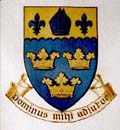
|
DOUAI CRICKET
A brief History - Compiled by Aubrey Balhetchet
Our thanks to Fr. Abbot for all the assistance given in this compilation.
and to his assistant archivist Alison Day for her technical expertise.
Photo Galleries
ST EDMUND'S COLLEGE, DOUAI, FRANCE
|
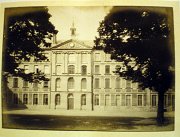
It is difficult to ascertain exactly when cricket began at Douai, France,
but the Rev. John O'Leary from Liverpool, a former pupil and keen cricketer,
writes in his memoirs of 1875-1890 that it must have begun about 25 years
before his time at the school. In a book called 'Catholic Trivia' by the
well-known Catholic writer Mark Elvins, OFMCap, the game 'catte' is mentioned.
To quote:
'... The young divines (seminarians) who attended Douay College in Flanders
during penal times invented what must be a precursor of cricket. 'Catte'
had one set of two stumps and was not unlike a similar game played at St
Omer College, the forerunner of Stonyhurst, the latter being one of the
early pioneers of cricket.'
Was this the beginning of 'French cricket' we ask ourselves? Maybe the
'J's beat the Benedictines to it on this occasion!
The first publication available with any cricket information is the St
Edmund's Douai Magazine of 1894. The editor apologises for omissions as
all records are lost. Masters and pupils made up the elevens and games
were played on appalling pitches.
Also recorded somewhere is a scorebook of the Royal Blues Cricket Club of the years1868-1870. This appears to be a club comprising distinguished Old Boys from various establishments, among them a monseigneur and two abbots. Perhaps we may find more facts on this in a later Old Boys section.
Some cricket was played right in front of the buildings known as the 'bounds'
and old photographic evidence shows that cricket nets were erected. Pitches were cut and laid on the 'Plain' which must have
been some sort of common land, as the French cavalry from time to time
would exercise there - forming some wonderful military evolutions right
over the cricket pitch. No surprise then that very low scores were recorded.
Masters - 35 and 41 - beat the boys - 34 and 33!
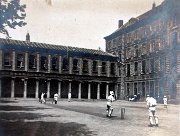
Later the ground was moved to an excellent area called Planques, between
the château and the lake, where conditions were much improved. It
is interesting to note that despite the poor batting conditions before,
only the 1st and 2nd XIs were allowed gloves and pads. Apparently the standard
of fielding was always good due to the rough outfields; thus when smoother
surfaces were encountered it reached a very high standard.
Some descriptions and early comments are amusing:
'J. Dean played very seldom, being more interested and engaged in the highly
aesthetic art of painting boats.'
'F. Middlehurst was a very successful bowler - bowling fast round arm.'
(Little wonder that Sri Lanka's Malinga the 'Slinger' is such a success.)
N.B. A cricket ball throw of 95 yards was recorded. 100 yards was run in 11 1/5 seconds, and in 1900 10 4/5 seconds was recorded.
The cost of the Douai Magazine was 3s. 3d. (interpretation for the new generation = 3 shillings and 3 pence).
It took a week and more than £5 to travel from Liverpool to Douai,
France.
The junior school were forced to make the cricket balls. Work began in
December and January and was a very unpleasant task: dabbling with wet
strips of cloth, hemp and tow and hammering them by means of a stick or
broken rounders bat into some semblance of a cricket ball before sewing
and waxing. Apparently they turned out well-shaped and 'things of beauty'.
One can only speculate how Ditcham would have fared?!
Going back to the vacations of the early '80s it was hoped that matches
could be played against St Edmund's Ware, Emeriti, Downside, Ampleforth
and Stonyhurst, but unfortunately nothing came of this.
Other interesting and amusing reports are also recorded. A match between
the Benedictines and Seculars resulted in the 'defeat of the aspirants
to the black-robed choir'. Around this time in 1894 there is also an end-of-season
report by the editor requesting fair play:
'Before concluding we ask our players, one and all, to follow the example
of the first game and abolish the still lingering custom of indulging in
a 'last ball' - at the expense of some poor person's head or of some other
more sensitive portion of his body.'
Sounds as though they could have done with TV and red cards - and helmets!
North vs South was another fixture and although scores remained low, games were keenly contested.
In 1896 a cricket league was formed of three elevens - Edmundians, O'Gregorians
and Dowegians. Single innings were limited to Sundays. By the early 1900s
games were played between masters, boys and Old Boys.
In 1901 there is evidence that the famous Rev. W.I. Rice had played a few games. The outfield was still rough but coconut matting was laid on the pitch.
WOOLHAMPTON - BERKSHIRE
1903 saw the return to England. Expelled from France under the Associations Law, approximately 30 clergy and 100 boys arrived at Charing Cross. The number of boys fell to 63 by 1911.
1905-1920: There are no publications or any reports on cricket during this period.
There were a few local fixtures during 1914-1918 but no reports exist.
Before the 'Park' was acquired in 1907 cricket was probably played on grounds
adjacent to the Abbey church and monastery but it is not certain when cricket
started in earnest on the 'Sanctum'. It certainly had by the'20s as in
1922 a cricket pavilion was built in honour of those 56 Old Dowegians who
died during World War I.
1920: Reports in magazines began again and the year saw Fr. Ignatius Rice (Headmaster
from 1915-1952) play in some matches, but only against club sides. He was
a first-class cricketer who played for Warwickshire during the holidays.
Matches were played against some of the same schools right up to the closure
of the School - Leighton Park, Reading, Newbury (St Bartholomew's), Nautical
College - and also included some club sides such as the Royal Dental School,
Hampstead Norris and Excelsior. Considering the small number of pupils
the team did well in the early'20s. Although only 7 matches were played,
a 78.5% success rate was recorded in 1920.
The star of the early'20s was M.J. O'Sullivan who in 1920 scored 103 not
out against King Alfred's School, Wantage and took 36 wickets for the season
and 34 the following year.
1922 saw one good bowling performance from A.J. Young who picked up 54 wickets at 11.03.
1923 produced a good bowling performance from C.A. Williams - 56 wickets at 8.30.
1924 had some good bowling performances from C.E. Caldwell with 35 wickets at 9.82 and from A.J. Cunningham with 35 wickets at 12.05.
In 1925 E.R. Gryspeerdt scored 103 not out vs the Invalids CC! This century, together
with M.J. O'Sullivan's in 1920, must be one of the first recorded at the
Park. The bowling successes were C.A. Williams, C.J. Cunningham, P.A. Plunkett
and H.E. Murray-Davey. (C.A. Williams ran the 100 yards in 10 4/5 seconds
and H. Murray-Davey threw a cricket ball 74 yards & 1 foot!)
The batting in 1926 was poor but K.H. Flood took 39 wickets at 10.15. Fr. Ignatius Rice - Headmaster since 1915 - played in a Douai XI vs Excelsior CC, scoring 109.
The mid- to late'20s produced nothing spectacular but good batting and
bowling performances were shared between M. McMurtrie and G. Warren-Darley.
In 1930 A.H. Coombes scored over 300 runs and took 55 wickets at 12.27. L.J. Foster held the School record with 62 wickets at 8.90.
There were average performances in the '30s, the best being in 1934 when they played 14, won 7, lost 4 and drew 3. In 1933 A. Devine scored 105 vs Reading School. There was 1 tie in 1935.
The best performances with bat and ball came from Long, Pooley and Smith,
and in the mid-'30s outstanding batting performances from Cooper, McNair,
Gartrell and Williams.
The stars of 1937 were Cooper, Walsh, Nicoll and Masterson and in 1938 the batting of Richardson and Vickerman was outstanding, the latter scoring an excellent century not out, the first ever made for the newly constructed Douai Society. Also in 1938 T.J. Walsh, a left-arm medium pace bowler, set a record which would stand forever. The details are worth recording:
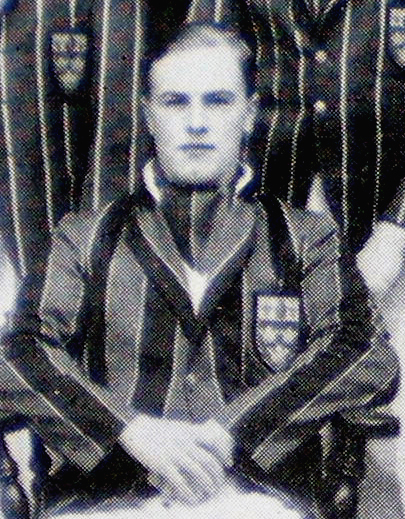 |
T J Walsh - 1937
Overs = 189.3, Maidens = 7, Runs = 550, Wickets = 64, Ave = 8.59.
- 10 for 72 vs Nautical College,
- 10 for 37 vs Emanuel School
- 7 for 26 vs Douai Society,
- 7 for 31 vs Downside Wanderers.
|
The two performances of 10 wickets in each single innings would never be beaten.
In 1939 and 1940 the stars of the batting were B.H. Richardson and Scratton while Walsh and Richardson were most successful with the ball. Dunphy also featured.
1941 saw the appearance of another Coombes - J.T. - the youngest of the three brothers and a very fine batsman. He was supported by M. Gregory, another fine cricketer, and Bland who did the bowling.
In 1942 Cary was the most successful with the bat, and Shaw and Gregory with the ball.
1943 was a poor season but D. Gregory was the most successful with strong bowling performances from Gregory, Shaw, Cuddon and Stokes. The performances of Cuddon and Stokes rolled off the tongue like the feats of Trueman and Statham, Laker and Lock, Lindwall and Miller, and was to continue for another 3 years. D. Gregory dominated the batting while Cuddon and Stokes produced bowling performances of 39 and 41 wickets respectively.
1944: The team were unable to play the usual fixtures. The batting was very weak. D. Gregory was the best batsman, and the weakness was compensated for by the very reliable bowling of Stokes and Cuddon, with averages of 7 and 8 respectively.
1945: Gregory once again was successful with the bat together with Waller,
and Cuddon and Stokes again were the successful bowlers,
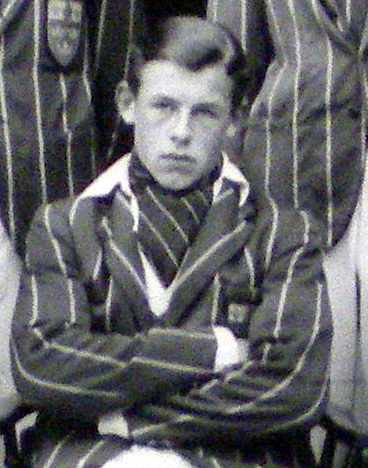 |
J. (Charlie) Cuddon1945
72 wickets in the season.
This remains the School record! |
J.A. Waller was once again successful with the bat in 1946, while Cuddon and Stokes, together with Blower, were the most successful bowlers.
John (Charlie) Cuddon was one of the fastest right-arm bowlers the School has seen and had played for the Oxford Authentics. Mike (Gus) Stokes was a right-arm medium pace bowler who bowled prodigious in-swingers. They were a formidable combination.
1947 witnessed a poor season with some promising performances from Swinhoe,
O'Brien, Price and Blower.
1948 saw another poor season but produced some good performances from McKiernan, Price, Gibson and Halligan.
1949: Another very average season with batting successes shared between Price, Gibson and McKiernan. The best bowling performances came from Halligan, Simpson and Price.
1950: This season was certainly an improvement on the late '40s with nearly
300 runs scored by Gibson and over 200 by McKiernan. Simpson, Halligan
and Orsi were the star bowlers with averages of 10.2, 10.5 and 12.1.
1951: To quote the cricket report for the season in the School magazine:
'The year 1951 will go down in the annals of Douai cricket as a black year.
Your correspondent can confirm that it was in fact one of the blackest
with his topping the batting and bowling averages! The bald and lamentable
fact is that not one of the teams succeeded in winning a single match.
However, it has to be said that the Junior School at Ditcham had a very
successful term, winning six, losing three, with two drawn.'
1952: After the blackest season of Douai cricket in 1951, it appears that there was a sudden dearth of cricket reporters in 1953, as not a single cricket report could be found! However, the batting was once again poor but two good bowling performances were put in from Griffith (12.3) and Chelley (12.5).
1953: Another very disappointing season with Griffith topping the batting and bowling averages, and he was awarded his colours at the end of the term.
1954: The highlights of the season were centuries by Chelley and Hopkin which ensured victory against the Old Boys; it was the fourth victory against a club side that season. There were no victories against any school side. Chelley topped the batting with 25.91 and Balhetchet the bowling with 8.10.
1955: Played: 13. Won: 5. Lost: 5. Drew: 3.
The side was captained by D. Hopkin who led with some fine performances of excellent fast bowling. Hopkin and Segal did the brunt of the bowling, taking 80 wickets between them of the 100 to fall. They were ably supported by Keating, Horgan and Morgan. The most successful batsmen were Segal, Hopkin, McNally, Stodart, Moriarty, C. Allanson and Keating.
On leaving school, Frank Keating (52-55) developed a very distinguished
career as a Guardian sports jounalist.

As a wonderful example of Frank's colourful prose, click to read his celebration of cricket at school taken from the Winter 89-90 Douai magazine, page 44 - 45.
Sadly, Frank died in 2013. Click to read his 'Guardian' obituary.
1956: Despite having 8 of the previous year's XI, the results were disappointing.
Segal topped the batting and bowling averages and was supported with the
bat by Stodart, C. Allanson and Treays, and in the bowling by Horgan and
D. Allanson.
1957: Played: 12. Won: 6. Drew: 6.
R. Segal was captain for the second successive year and had a very successful
team. Segal's own performance was outstanding, scoring well over 300 runs
- twice as many as the next best and taking 45 wickets at 8.64. He was
well supported in the batting by FitzPatrick, Kitchener, Scott, Horgan,
Filmer and C. Allanson. Apart from Segal's 45 wickets, John and Horgan
took 26 wickets apiece.
1958: The team, captained by M. Horgan, had a very reasonable season, winning 6, drawing 2 and losing 4. Kitchener, Filmer and Horgan got the runs while 83 wickets were shared between Horgan and John, with D. Allanson chipping in with 15.
1959: A young and inexperienced side which showed great promise for the future. H. Sinclair was the leading batsman and kept wicket well, while Barnsley the captain played some good innings. P. Jeffery took the greatest number of wickets. The fielding was of a high standard. The successful batsmen were Moore, Sinclair, Furlonger and Barnsley, and the successful bowlers Welch, Jeffery, C. Blackburn and P. Blackburn.
1960: As with the previous year it was a young side. The best batters were Sinclair, Moore, Furlonger and C. Blackburn. The most successful bowlers were C. Blackburn, P. Jeffery and C. Date.
1961: Matting nets were used for the first time and the records showed that this was a significant improvement. Four matches were won, one tied, and three others should have been won, including that against the MCC. Batting was once against the weakest department but F. Aung scored a century against the Buccaneers and topped the batting averages. P.J. Jeffery led the side well and had a good all-round season. The leading batsmen were Aung, Jeffery and Hall and the most successful bowlers were Jeffery, Date and Lewis.
1962: Won: 4. Drew: 6.
It was a good season, with most of the drawn games in Douai's favour. There
was some excellent batting from A.J. Keeble, Hall, Greenwood and Jeffery,
and good bowling by Jeffery, Greenwood and Caldwell.
Batting: Keeble (378 runs with an average of 37.8), Greenwood, R.G. Hall, P.C. Jeffery, Smallwood.
Bowling: B.C. Caldwell, Greenwood, Jeffery.
1963: There was a great improvement this season with 12 matches played, 5 won, 3 lost and 4 drawn.
Batting: The runs were accumulated by Jeffery (244), R.G. Hall (203) and Greenwood (199).
Bowling: Caldwell took 37 wickets and Jeffery 32, backed up by Greenwood (15).
1964: A new XI had to be built and no matches were won, with 6 lost. However, there was some good potential shown by the youngsters. The batting relied on Matthews, Clouston and Kulesza. Bill Osborn was head and shoulders above everyone with 24 wickets and turned out to be one of the fastest bowlers the school had produced.
1965: Won: 0. Lost: 10. Drew: 3.
A somewhat disappointing season with contributions only from Clouston with the bat and Osborn with the ball.
1966: The rot was stopped by B. Coultas and his team with 6 matches won, 5 lost and 2 drawn.
Batting: Coultas, Lowe, Dunlop, Reddin-Clancy, Usher-Somers.
It was an excellent season for Osborn - one of the fastest bowlers the school has seen - with 57 wickets. He was well supported by Lowe, Ashforth and Coultas.
1967: Won: 4. Lost: 4. Drew: 3.
The batsmen were Olivier, Usher-Somers, Miller, Reddin-Clancy, and Grun. Bowling was carried out by Smith (29 wickets), Miller (22 wickets), Grun and Ashforth. It was a fair season, captained by P. Fletcher.
1968: Played: 11. Won: 3. Lost: 0. Drew: 6.
The weather was bad this summer but the results were more than fair. The
stat of 'Lost: 0' was not too familiar a figure in Douai's history, but
in 1968 it augured well for the beginning of the new coach's very successful
career. John Shaw had arrived.
Your correspondent would not be able to do justice to John Shaw's achievement
in this history - as a cricket coach and headmaster's assistant - and refers
readers to Frank Keating's article on John's Farewell in the Douai Society's
Newsletter of Summer 2009.
Fr. Augustine, who was sports master at the time, had told your correspondent
- and in an official speech - that the best thing he ever did for Douai
was to employ the services of John Shaw. More of Shaw's contribution to
Old Boys cricket and Cricket Week in the next history.
In 1968 the side was captained by B. Lowe - an excellent all-rounder - averaging 38.87 with the bat and well supported by Olivier (28.25). Martin Sullivan was the star swing bowler with 37 wickets at 11.45 and Lowe took 20 wickets at 20.2.
1969: Played: 14. Won: 3. Lost: 2. Drew: 8.
M. Sullivan was now captain and did a very good job. He had another good season as opening bowler.
The results were better than appeared as Douai had the better of most of
the 8 drawn games and would have won them. The encouraging fact was that
over 50% of the batting order contributed - although aggregates weren't
particularly high - and 4 bowlers contributed well. Three batsmen got 50s
- Coombes, Canter and McLean - and were well supported by Catton, McCall
and Crean. Sullivan and A. Allen were the spearhead of the attack, ably
supported by McLean and McCall.
1970: Played: 15. Won: 11. Lost: 2. Drew: 2.
This season was considered to be one of the best on record.
The two matches lost were against club sides - the Public School Wanderers and the Buccaneers. Pangbourne was the only school to score over 100 against them. It is interesting to note that Douai batted second on every occasion of the 15 matches played. G. Bramall - at the age of 16 - set a school record with an aggregate of 504 runs at an average of 42.00. He scored a brilliant 120 not out against the MCC. He was well supported by J. Coombes with 228 runs and an average of 38.00. E. Vale scored 247 runs at 22.45. The outstanding bowlers were S. Bond with 61 wickets at 8.59 and A. Allen with 55 at 10.09. The fielding was also very good, with C. Vaughan and J. Wills quite outstanding.
1971: It would be difficult to follow the success of the previous season especially
as the wickets were very soft but nevertheless the team did extremely well,
with 6 won, 2 lost and 3 drawn. The side was captained by A. Allen who
once again had a successful season with 33 wickets at 8.03, as did Bond
with 29 at 11.89. A. Haigh took 15 at 10.2.
Despite the weather, another very successful season.
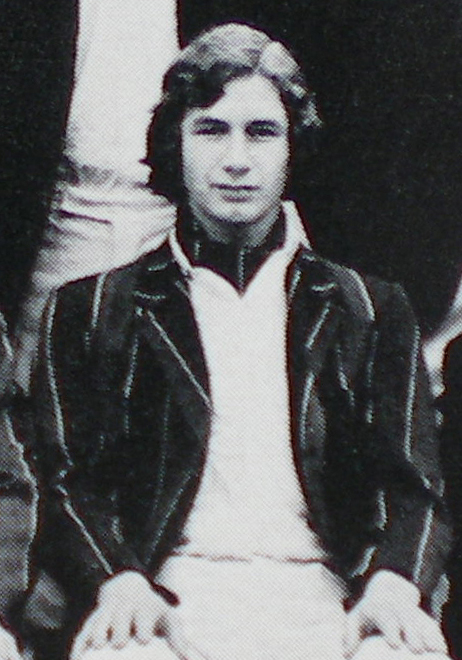 |
1970 G. Bramall
Runs - 504 Average - 42
1971 He did not enjoy the success of the previous season because of very
damp conditions but nonetheless topped the aggregates again with 161 runs
and was more than ably supported by E. Vale, D. Allen and G. Haigh.
. |
1972: Despite the bad weather with 2 abandoned and 2 cancelled matches, 2 games were won, 2 lost and 5 drawn.
D. Allen was by far the best batsman with 242 runs at an average of 34.5. He was well backed by Barratt, Morris, Fletcher, E. Vale and Maclennan. Simon Morris bowled well throughout the season with 27 wickets and was well supported by Moritz, Maclennan, King and Stack. David Allen kept wicket brilliantly.
1973: Won: 7. Lost: 2. Drew: 5.
Another brilliant season.
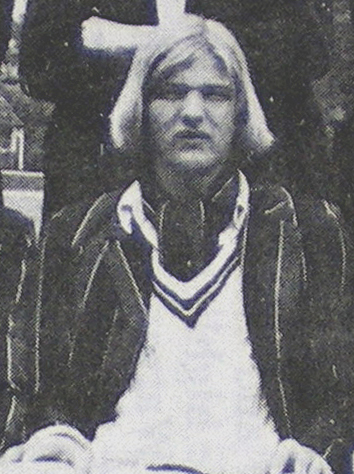 |
The side was captained by David Allen (pictured Left) who equalled the school record of aggregate runs for a season (504) held by G. Bramall in 1970. It is interesting to note that David kept wicket brilliantly during the previous season but it was decided that his very fast bowling would be useful, and it certainly was, with 26 wickets at 18.5. He was ably backed up by Shanahan with 29 wickets and Moritz, Barratt and Maclennan in support. Paul Fletcher took on the job of 'glove-man' behind the stumps and not only did he do a good job, he got the second highest aggregate of runs with 222. All the batsmen contributed well. They were Watson, Fletcher, Hill, Stack, Maclennan and Barratt. Another interesting point: David Allen was an outstanding fielder! No one knows why David never tried to go on to play a higher grade of cricket but he was very happy having fun with the Old Boys and trying to get his golf handicap back to 2!!! He was also a very big hitter of the little ball.
|
At this stage it would be interesting to compare the two record holders with the bat:
G. Bramall (1970):
Innings: 15
Not Out: 3
Highest Score: 120 n.o. (vs MCC)
Runs: 504
Average: 42.00 |
D. Allen (1973):
Innings: 14
Not Out: 6
Highest Score: 84 n.o. (vs MCC)
Runs: 504
Average: 63.00 |
Bramall was a slightly punchy dominant-right-hand batsman with wonderful
timing, and excelled on good fast wickets. His driving off the front foot
was a joy to watch.
Allen was tall with a wide range of shots. He was a forceful right-hand batsman with a powerful hook and pull shot.
1974:
The success continued with 15 matches played, 5 won, 1 lost, 8 drawn and 1 tied.
The School played well and the only loss was to Reading School. The encouraging fact was that all the batsmen and bowlers were successful.
The side was very well captained by P. Maclennan. His batting was always exciting and topped the aggregates with 284 runs. He was a useful off-spinner and a very good fielder.
Three batsmen scored well over 200 runs while 2 others nearly 200. They were Maclennan, Hill, Farfan, Button, Vernon and Shanahan. T. James picked up 26 wickets, S. Moritz 20, M. Shanahan 28 and Maclennan 16.
The match against the Old Boys resulted in an exciting tie - 97 - the first in 40 years.
1975: Played: 16. Won: 4. Lost: 1. Drew: 10.
After a wintry start to the season the team performed very well, losing only 1 match. The side was well captained by A. Hill but unfortunately the table of statistics was not printed. There were some fine performances. The 1st XI squad was A. Hill (capt.), C. Vernon, M. Howarth, M. Button, P. Farfan, T. James, S. Dunbar, P. Hearn, R. Bayliss, P. Tomlinson, M. Shouten, P. Beven, C. Vale.
1976: Played: 14. Won: 3. Lost: 3. Drew: 8.
A slightly disappointing season. C. Vale was a very good captain and was singled out by the coach for his help on and off the field.
There is no averages table but the team did well overall: C. Vale (capt.), T. James, P. Tomlinson, P. Beven, B. Stack, H. Young, D. Akkermans, G. Vernon, J. Forsyth, M. Gale, R. Dunbar, S. Dunbar.
1977: Played: 12. Won: 6. Lost: 2. Drew: 4.
The season started well with some fine fast bowling from Julian Forsyth and G. Vernon who kept up the good form throughout the season.
There were some good performances from the batsmen and bowlers and the side was captained very successfully by Henry Young. Richard Keeble was making his first appearances for the 1st XI at the age of 13.
H. Young (capt.), J. Forsyth, S. Dunbar, G. Vernon, M. Gale, R. Dunbar, K. Tomlinson, H. Richards, S. Ellis, R. Keeble, P. Walker, J. Richards.
1978:
The success continued with 13 matches played, 7 won, 1 lost and 5 drawn.
It was a grand start to the season by beating St George's Weybridge by
9 wickets, fast bowler Julian Forsyth taking 9 wickets for 7 and winning
the Slazenger Award for May. Julian Forsyth and Richard Keeble were two
of Douai's best all-rounders. They were very well supported by all the
batsmen and bowlers.
The only match lost was to the MCC and by only 34 runs. Chris Rudd (off-spin), in his first bowl for the 1st XI at the age of 13, took 2-13. Julian Forsyth went on to play for the West of England Schoolboys and H.M.C. Southern Schools versus the Rest.
The whole team played well and was a very good side indeed: J. Forsyth (capt.), K. Tomlinson, H. Richards, P. Farfan, J. Richards, C. Whitworth. J. Joyce, N. Murphy, A. Bush, R. Keeble, J. Eldridge. J. Forsyth topped the batting and bowling averages and picked up 54 wickets.
1979: Played: 15. Won: 4. Lost: 2. Drew: 7.
The coach said that although the results do not reflect it, this was one
of the most positive sides he'd coached and if not for the weather many
more games would have been won. Nonetheless the results are very fair.
Richard Keeble, one of the finest all-rounders ever seen at Douai, finished top of the batting and bowling averages. There was only one real disaster all season and that was when Abingdon bowled them out for 88. But they rose from the ashes immediately after by defeating the MCC. There were some fine performances by the team: J. Richards (capt.), J. Eldridge, N. Murphy, C. Whitworth, J. Joyce, C. Rudd, R. Keeble, A. Bush, D. McGuckin, S. Booth, C. Mauduit, D. Joyce.
1980: Played: 15. Won: 3. Lost: 1. Drew: 11.
Though it may appear boring, nearly all the drawn games were very much
in favour of Douai. Keeble took 9-40 against St George's Weybridge, and
scored 66 not out. Chris Rudd knocked a brilliant century not out against
Woolhampton.
Richard Keeble got 100 against St Bartholomew's Newbury and was offered
a summer contract with Hampshire. He was outstanding with bat and ball.
Chris Rudd, the other outstanding all-rounder, got a trial with Warwickshire.
This was a very good and successful team: C. Whitworth (capt.), Keeble, Myers, Bush, Johnston, Darby, D. Joyce, Dawson, Jones, M. McClement, Rudd.
1981: Played: 13. Won: 5. Lost: 2. Drew: 6.
A good start to the season was made by beating St George's Weybridge by
8 wickets, Joyce and Keeble getting the runs. The season continued very
successfully, followed by the usual tour to Somerset. This was Richard
Keeble's fifth and final year in the 1st. Richard must rank as one of the
finest all-round cricketers Douai has seen. He was selected for the Rest
against Southern Schools and offered a contract with Hampshire.
It was the coach's view the Chris Johnson was the best wicketkeeper/batsman
since John Coombes - praise indeed.
This was a very good squad of cricketers: R. Keeble (capt.), C. Johnson, J. Darby, D. Joyce, T. Bedford, F. Ingrams, S. Dawson, A. Parkin, M. McClement, B. Richards, P. Brockman.
1982: Played: 14. Won: 2. Lost: 5. Drew: 5.
This side never really showed their true potential but there were good games against Reading, Magdalen and Bearwood.
A. Weston, C. McPherson, H. Thompson, B. Richards, R. Vitali, M. Astley, R. Booth, A. Parkin, M. McClement (capt.), F. Ingrams, S. Dawson, T. Bedford.
1983: Played: 12. Won: 2. Lost: 5. Tied: 1. Drew: 4.
The teams were usually playing on good wickets but in the month of May
the wickets were puddings. The results were not good. Some interesting
news, especially for the Old Boys: the Berkshire Gents couldn't raise a
side to play the school!
The side improved with better weather and on drier pitches the results
were more promising. Chasing Bearwood's 160-4 (dec.), the side won with
7 wickets to spare: Thompson 40, Mott 57 n.o., Dawson 38 n.o. Tom Bedford
61 n.o. vs Abingdon in a drawn game. Dawson 4-49.
There was a high-scoring drawn game against the Old Boys.
Simon Dawson captained the side well and had four successful years in the side, as did vice-captain Tom Bedford after three years. Both were leavers.
S. Dawson (capt.), L. Bedford, Thompson, T. Bedford, B. Richards, N. Peters, Weston, Pullan, Noble, Vitali, Bowe, Mott, Harwood.
1984: Played: 15. Won: 8. Lost: 2. Drew: 5.
One of the best seasons since 1970. After losing to St George's at the
beginning of the season not another game was lost until the last match
of the term.
There were some very good performances, as can be seen from the averages below:
BATTING:
R. Pullan: 477 runs. Average: 47.7.
C. Adolph: 369 runs. Average: 26.5.
BOWLING:
R. Weston: 58 wickets at 11.5.
R. Vitali : 42 wickets at 15.3.
G. Chesterman: 20 wickets at 14.4.
1985: Played: 13. Won: 2. Lost: 5. Drew: 6.
Weston captained well and batted courageously. Chesterman, the vice-captain, was the leading wicket-taker. Peters, a fine batsman and exceptional fielder, was the leading run-scorer. Strong got some runs but needed fast and hard wickets. S. Shaw, a fine all-rounder, should have played more matches earlier in the season.
R. Weston (capt.), G. Chesterman, Strong, Peters, Brown, Flanagan, Johnstone, Blackwell, Read, J. Joyce, Opia.
1986: Played: 10. Won: 1. Lost: 5. Drew: 4.
The team never showed their true potential this year. Quite a few matches were cancelled owing to bad weather.
Mark Brown did well as captain.
Glendinning, Parker, Flanagan, Brown (capt.), Blackwell, Graham, Urquhart, Corrigan, Duckney, Eckersley, Opia, J. Joyce, Lumb.
1987:
Not a great season, mainly due to a lack of runs.
One of the best performances was against the Old Boys who scored 227, with a response from the School of 165-8 and M. Allen scoring 90 not out.
C. Opia (capt.), N. Bogdanovic, J. Joyce, D. Corrigan, T. Millsop, R. Lumb, J. Roddis, S. Goodson, M. Allen, M. Robinson, T. Padgham.
1988: Played: 11. Lost: 4. Drew: 4. Abandoned: 3.
A disappointing season but all members of the team played well at times.
Millsop, Padgham, Allen, Adcock, Roddis, Sharpley, Tierney, Bogdanovic, Lumb (capt.), Goodson, Connor.
1989: Played: 12. Won: 6. Lost: 1. Drew: 5.
This was a strong batting side that was not bowled out all season and nos. 10 and 11 came to the crease only against the Old Boys. Richard Lumb captained well and had a very good all-round season.
R. Lumb (capt.), D. Sharpley, J. Millsop, J. Adcock, R. Tierney, N. Saw, D. Berrell, M. Allen, H. Goodson, I. Anison, G. Cherry.
1990: Played: 12. Won: 3. Lost: 2. Drew: 6. Abandoned: 1.
The highlight of this season was against the MCC who scored 210-2 (dec.). In reply the School scored 205-6 with a brilliant 115 by M. Allen.
Allen scored nearly 500 runs with an average of 52.
M. Allen (capt.), Knight, Berrell, Anison, Saw, Goodson, Jopson, Bartlett, Roddis, Newman, Brampton.
1991:
A disappointing season, despite a new bowling machine. The bursar felt Mr Shaw was too old to bowl anymore!
There were some fine performances by Mark Roddis, Charles Nicoll, Rupert Leach, Nick Lumb and Eja Opia.
1992:
The team wasn't very successful this year but Nick Jepson's side really
enjoyed their cricket. It was a very young side but 8 would be back the
following year. They held their own on most occasions. Colours went to
Charles Nicoll, Rupert Leach and Nick Jepson.
1993: Played: 15. Won: 2. Lost: 3. Drew: 10.
The team had difficulty in bowling sides out. One of the best performances
was from the captain R. Leach vs Reading with 68 and 5 for 43 against the
Old Boys. There was a record opening stand of 158 vs St Benedict's by D.
McClement and O. Scott.
1994:
Rain had the biggest say this season but D. Wilson scored a brilliant 100 against Woolhampton.
J. Wicks 50 vs Pangbourne and S. Wicks 50 vs Woolhampton.
Igbon took 5 wickets against Oratory.
Duncan McClement (capt.), Tolu Igbon, Darren Wilson and James Wicks were awarded their colours.
This was John Shaw's last year. D. McClement the captain presented John
with a silver tray with the names of captains over the last 26 years. John's
wife Angela was awarded 1st XI half-colours!
1995:
After John Shaw, the master in charge of cricket was Gareth Jones who was
assisted by ex-Hampshire player Mark O'Connor.
This year the captaincy was shared between A. Roddis and B. Briggs. The only win of the season was a fine one in chasing 204 against the Old Boys.
Ben Briggs was awarded the Cricket Cup. He, Roddis, Mills and Wicks were awarded colours.
A. Roddis, B. Briggs, S. Wicks, J. Midmore, Hamilton, Mills, Walker, Botcherby, Grobel, Hawke, Byrne, Bairstow.
1996:
Wicks, Fox, Carbury, Byrne G. Carbury, Bairstow, Botcherby, Hawke, Hamilton, Grobel, Midmore, Dickwood.
The Mark Allen Cricket Bowl for the best cricketer went to captain Simon Wicks.
The highlight of the batting was the 57 n.o. of James Bairstow vs MCC.
1997: Played: 9. Won: 2. Lost: 6. Drew: 1.
The season was badly affected by weather.
Edward Botcherby knocked 63 n.o. against Woolhampton and took a hat-trick vs Bearwood.
The Worrall Trophy went to Mark Bermingham and the Clubman's Award to Richard
Sims.
Half-colours went to Patrick Vaughan-Fowler, Mark Bermingham, Tim Carbury and Philip Robinson.
Tim Carbury, Philip Robinson, Giles Carbury, Richard Sims, Patrick Vaughan-Fowler, James Theunissen, Petch Boonvong, Simon Fox, James Bairstow, Edward Botcherby, Mark Bermingham.
1998:
With another rain-affected season, 8 matches were completed.
John Shaw returned to help with the coaching and the team remained unbeaten until half-term when they lost narrowly to the MCC.
The run-getters were Theunissen, Fox, E. Botcherby, and V. Prescott and the wicket-takers were Prescott, Theunissen, Botcherby and Carbury.
James Theunissen averaged 43 with the bat.
R. Bedford, W. Melia, V. Prescott, J. Theunissen, G. Murphy, R. Marshead, E. Sayers, M. Bermingham, S. Fox, E. Botcherby (capt.), T. Carbury, P. Robinson.
Edward Botcherby and Simon Fox - keeper for the past 3 years - were awarded full colours.
1999:
The last term of Douai School and there is very little on the 1st XI cricket except that they enjoyed some promising and competitive games.
Vincent Hackshaw, Nicholas Goulden, Patrick Brown, Giles Murphy, Thomas Conlon, Benjamin Adams, Michael Botcherby, Patrick Ryan, Vincente Prescott (capt.), Thomas Sample, Thomas Nurick.
CAPTAINS
1918 P. MURPHY
1919 P. MURPHY
1920 W. PATERSON
1921 M. O'SULLIVAN
1922 J. DUNNE
1923 C. WILLIAMS
1924 L. CAREY
1925 E. GRYSPEERDT
1926 P. PLUNKETT
1927 L. O'REILLY
1928 M. McMURTRIE
1929 W. CARTY
1930 A.H. COOMBES
1931 W. MEYNELL
1932 F. MARTENS
1933 J. POLGLASE
1934 R. POOLEY
1935 R. POOLEY
1936 R. McNAIR
1937 R. COOPER
1938 J. ROWLEY
1939 T. WALSH
1940 B. RICHARDSON
1941 J. COOMBES
1942 M. GREGORY
1943 M. GREGORY
1944 J. MILLS
1945 J. CUDDON
1946 J. CUDDON
1947 J. ELLIOTT
1948 R.F. GUNN
1949 C.E. SWINHOE
1950 P. HALLIGAN
1951 E.J. HORGAN
1952 B.A. ORSI
1953 B.J. WAGHORN
1954 S.C. BOTCHERBY
1955 D. HOPKIN
1956 R. SEGAL
1957 R. SEGAL
1958 M.J. HORGAN
1959 R. BARNSLEY
1960 C. BLACKBURN
1961 P.J. JEFFERY
1962 R.G. HALL
1963 R.G. HALL
1964 A. AUSTIN
1965 J. CLOUSTON
1966 B. COULTAS
1967 P. FLETCHER
1968 B. LOWE
1969 M. SULLIVAN
1970 J. COOMBES
1971 A.J. ALLEN
1972 E. VALE
1973 D. ALLEN
1974 P. MACLENNAN
1975 A. HILL
1976 C. VALE
1977 H. YOUNG
1978 J. FORSYTH
1979 J. RICHARDS
1980 C. WHITWORTH
1981 R. KEEBLE
1982 M. McCLEMENT
1983 S. DAWSON
1984 R. PULLAN
1985 R. WESTON
1986 T. BROWN
1987 C. OPIA
1988 R. LUMB
1989 R. LUMB
1990 M. ALLEN
1991 J. SAW
1992 N. JEPSON
1993 R. LEACH
1994 D. McCLEMENT
D. IGBON
1995 A. RODDIS
B. BRIGGS
1996 S. WICKS
1997 J. BAIRSTOW
1998 E. BOTCHERBY
1999 V. PRESCOTT
COACHES
Fr. Ignatius Rice in the early days at Woolhampton must have played a significant part in the coaching, assisted by a member of the clergy.
Frank Shipston, ex-Notts, also helped out in the 30s and was coach in the
50s. 'Shippy' ('Stay there, wait for it and ROONS'll come' and 'That
Booger Alred has taken my mower again') played in the famous Nottinghamshire sides that included Harold Larwood and Bill Voce, and for several years he had been the oldest surviving professional in England. Shippy died on 6 July 2005, three weeks before his 99th birthday.
The coach in the early 50s was Alan Peach, ex-Surrey, who was the epitome
of the old school pro: gnarled, very tanned, with an upper lip as heavily
nicotine-stained as the fingers of his right hand. He smoked his fags right
down to the millimetre, sometimes while demonstrating how to clean a cricket
bat with a piece of broken glass. His favourite pub was the Rising Sun
on the Bath Road where he could be seen entertaining some youths who looked
suspiciously like white-flannelled cricketers!
After 'Shippy' the coach was an Old Boy - John (Charlie) Cuddon, a graduate
of Oxford University who was making his way as an author and playwright.
Charlie himself was a very good fast bowler and once took 72 wickets in
a season at Douai - the School record!
In the 60s Fr. Laurence Devine and Paul Cheetham, the Classics master,
took the elevens up to 1967, after which in 1968 John Shaw began his very
successful career and transformed cricket at Douai for the next 26 years.
John joined the Lord's groundstaff in the 50s before he was poached by former Somerset captain and founder Headmaster of Millfield School, R.J.O. Meyer. He played for the Somerset Minor Counties XI, the Army and the Combined Services.
John Shaw's Farewell, by Frank Keating, can be found in the Douai Society's
Newsletter of Summer 2009.
After John Shaw's departure the cricket coach was Gareth Jones.
|
|
| |

